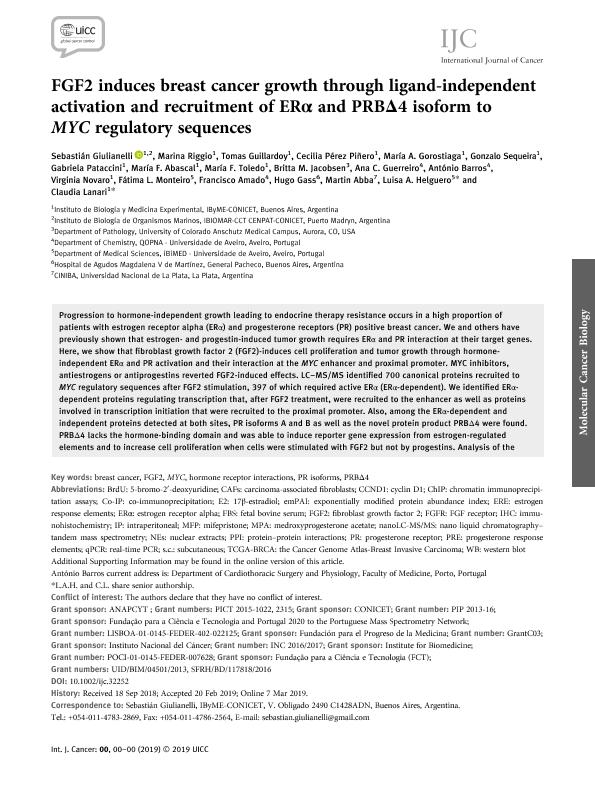Artículo
FGF2 Induces Breast Cancer Growth through Ligand-Independent Activation and Recruitment of ERα and PRB∆4 Isoform to MYC Regulatory Sequences
Giulianelli, Sebastian Jesus ; Riggio, Marina
; Riggio, Marina ; Guillardoy, Tomás
; Guillardoy, Tomás ; Pérez Piñero, Cecilia; Gorostiaga, María A.; Sequeira, Gonzalo Ricardo
; Pérez Piñero, Cecilia; Gorostiaga, María A.; Sequeira, Gonzalo Ricardo ; Pataccini, Gabriela
; Pataccini, Gabriela ; Abascal, María F.; Toledo, María Florencia; Jacobsen, Britta M.; Guerreiro, Ana C.; Barros, António; Novaro, Virginia
; Abascal, María F.; Toledo, María Florencia; Jacobsen, Britta M.; Guerreiro, Ana C.; Barros, António; Novaro, Virginia ; Monteiro, Fátima L.; Amado, Francisco; Gass, Hugo; Abba, Martin; Helguero, Luisa A.; Lanari, Claudia
; Monteiro, Fátima L.; Amado, Francisco; Gass, Hugo; Abba, Martin; Helguero, Luisa A.; Lanari, Claudia
 ; Riggio, Marina
; Riggio, Marina ; Guillardoy, Tomás
; Guillardoy, Tomás ; Pérez Piñero, Cecilia; Gorostiaga, María A.; Sequeira, Gonzalo Ricardo
; Pérez Piñero, Cecilia; Gorostiaga, María A.; Sequeira, Gonzalo Ricardo ; Pataccini, Gabriela
; Pataccini, Gabriela ; Abascal, María F.; Toledo, María Florencia; Jacobsen, Britta M.; Guerreiro, Ana C.; Barros, António; Novaro, Virginia
; Abascal, María F.; Toledo, María Florencia; Jacobsen, Britta M.; Guerreiro, Ana C.; Barros, António; Novaro, Virginia ; Monteiro, Fátima L.; Amado, Francisco; Gass, Hugo; Abba, Martin; Helguero, Luisa A.; Lanari, Claudia
; Monteiro, Fátima L.; Amado, Francisco; Gass, Hugo; Abba, Martin; Helguero, Luisa A.; Lanari, Claudia
Fecha de publicación:
03/2019
Editorial:
John Wiley & Sons Inc
Revista:
International Journal of Cancer
ISSN:
0020-7136
e-ISSN:
1097-0215
Idioma:
Inglés
Tipo de recurso:
Artículo publicado
Clasificación temática:
Resumen
Progression to hormone-independent growth leading to endocrine therapy resistance occurs in a high proportion of patients with estrogen receptor alpha (ERα) and progesterone receptors (PR) positive breast cancer. We and others have previously shown that estrogen- and progestin-induced tumor growth requires ERα and PR interaction at their target genes. Here, we show that fibroblast growth factor 2 (FGF2)-induces cell proliferation and tumor growth through hormone-independent ERα and PR activation and their interaction at the MYC enhancer and proximal promoter. MYC inhibitors, antiestrogens or antiprogestins reverted FGF2-induced effects. LC?MS/MS identified 700 canonical proteins recruited to MYC regulatory sequences after FGF2 stimulation, 397 of which required active ERα (ERα-dependent). We identified ERα-dependent proteins regulating transcription that, after FGF2 treatment, were recruited to the enhancer as well as proteins involved in transcription initiation that were recruited to the proximal promoter. Also, among the ERα-dependent and independent proteins detected at both sites, PR isoforms A and B as well as the novel protein product PRBΔ4 were found. PRBΔ4 lacks the hormone-binding domain and was able to induce reporter gene expression from estrogen-regulated elements and to increase cell proliferation when cells were stimulated with FGF2 but not by progestins. Analysis of the Cancer Genome Atlas data set revealed that PRBΔ4 expression is associated with worse overall survival in luminal breast cancer patients. This discovery provides a new mechanism by which growth factor signaling can engage nonclassical hormone receptor isoforms such as PRBΔ4, which interacts with growth-factor activated ERα and PR to stimulate MYC gene expression and hence progression to endocrine resistance.
Palabras clave:
BREAST CANCER
,
FGF2
,
HORMONE RECEPTOR INTERACTIONS
,
MYC
,
PR ISOFORMS
,
PRB∆4
Archivos asociados
Licencia
Identificadores
Colecciones
Articulos(CCT - LA PLATA)
Articulos de CTRO.CIENTIFICO TECNOL.CONICET - LA PLATA
Articulos de CTRO.CIENTIFICO TECNOL.CONICET - LA PLATA
Articulos(IBIOMAR)
Articulos de INSTITUTO DE BIOLOGIA DE ORGANISMOS MARINOS
Articulos de INSTITUTO DE BIOLOGIA DE ORGANISMOS MARINOS
Articulos(IBYME)
Articulos de INST.DE BIOLOGIA Y MEDICINA EXPERIMENTAL (I)
Articulos de INST.DE BIOLOGIA Y MEDICINA EXPERIMENTAL (I)
Citación
Giulianelli, Sebastian Jesus; Riggio, Marina; Guillardoy, Tomás; Pérez Piñero, Cecilia; Gorostiaga, María A.; et al.; FGF2 Induces Breast Cancer Growth through Ligand-Independent Activation and Recruitment of ERα and PRB∆4 Isoform to MYC Regulatory Sequences; John Wiley & Sons Inc; International Journal of Cancer; 145; 7; 3-2019; 1874-1888
Compartir
Altmétricas



